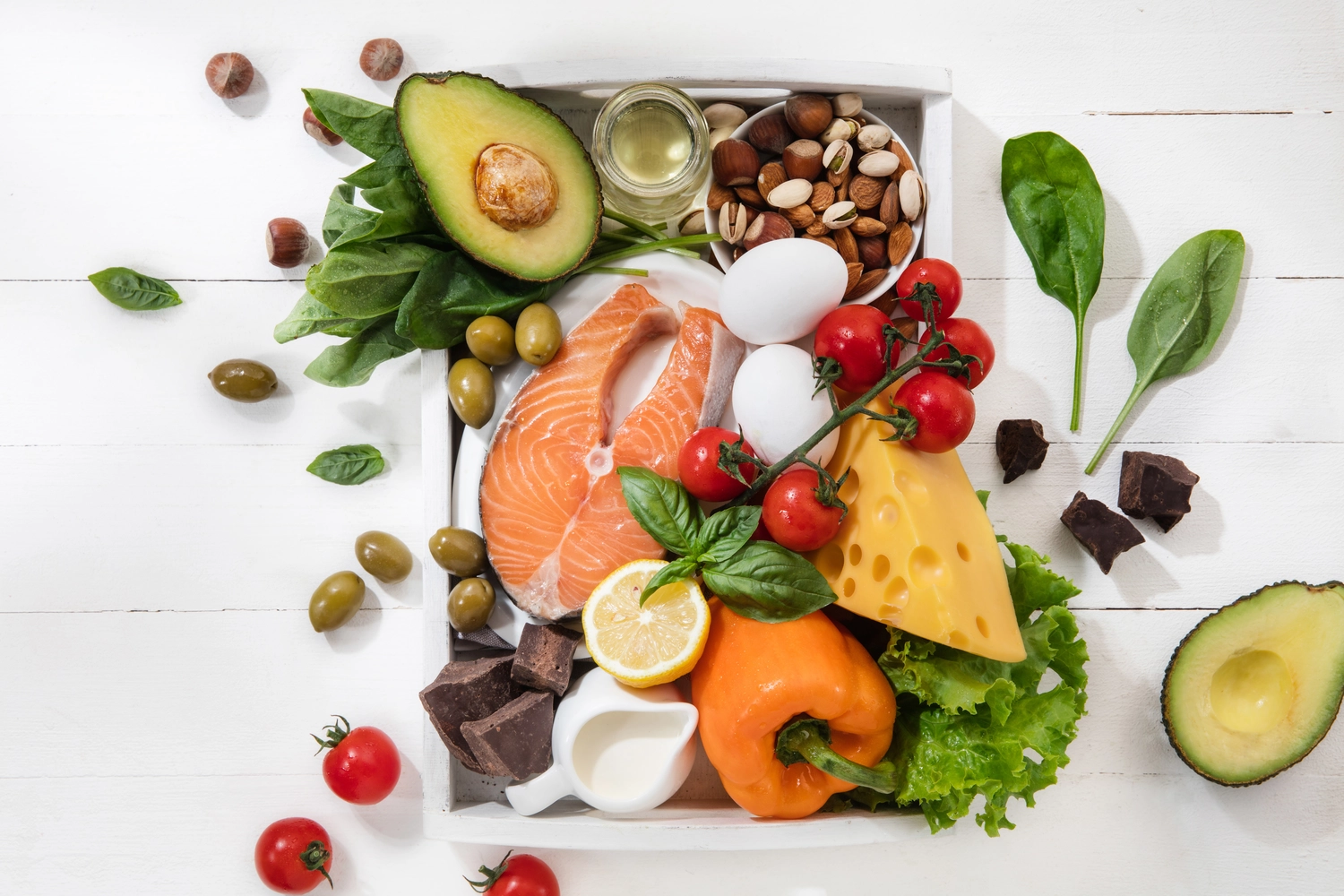
Keto diet
What is The Keto Diet?
Keto diet is a diet with few carbs, enough protein, and a lot of fats to make your body make ketones.
Ketones are made in your liver and used by your body for energy when you don’t have enough sugar in your blood.
The keto diet can help you lose weight and feel less hungry. It also makes you more alert and focused without the sugar highs from carbs.
Different Keto Diets:
There are a few kinds of keto diets based on how much fat, carbs, and protein you eat.
– Standard Ketogenic Diet (SKD): You eat 5% carbs, 20% protein, and 75% fat.
– Cyclical Ketogenic Diet (CKD): You switch between days of eating more carbs and days of eating fewer carbs.
– Targeted Ketogenic Diet (TKD): If you work out a lot, you eat carbs on days you exercise.
– High-Protein Ketogenic Diet: You eat 60% fat, 35% protein, and 5% carbs.
Benefits of Keto:
The diet can help with:
Eating less.
Losing weight, which can improve health problems caused by being overweight.
Lowering blood sugar and cholesterol.
Clearing up acne.
Lowering cancer risk.
Better heart health.
Protecting your brain.
Starting Keto for Weight Loss:
To do keto right and avoid problems, you should:
- Eat natural fats.
- Eat vegetables and a bit of fruit.
- Drink lots of water.
- Eat the right amount of protein.
- Stick with it to lose weight in a healthy way.
Keto Diet Side Effects:
At first, you might feel tired, have stomach issues, trouble sleeping, or feel sick.
It’s smart to talk to a doctor to find the best way to do keto for your health.
What to Eat on Keto:
– Seafood: such as oysters and salmon.
– Vegetables: Avocado, broccoli, cucumber, spinach, and tomatoes.
– Cheese.
– Meats and poultry.
– Eggs.
– Olive oil.
– Nuts.
How Can You Succeed on the Keto Diet?
Electrolyte Management
When transitioning to a ketogenic diet, your body undergoes significant metabolic changes, including the way it handles electrolytes.
Electrolytes, such as sodium, potassium, and magnesium, are vital for maintaining fluid balance, nerve transmission, and muscle function.
As carbohydrate intake lowers, the body begins to excrete more water and electrolytes. This can lead to imbalances, which might manifest as fatigue, headaches, or cramps, often termed as the “keto flu.”
To counteract this, adding salt to your meals and consuming electrolyte-rich foods like leafy greens, avocados, nuts, and seeds is recommended.
For some, supplementing with electrolyte tablets or powders may be necessary to ensure optimal levels are maintained, especially during the initial stages of ketosis where adjustments are most pronounced.
Exercise Regularly
Incorporating a mix of high-intensity interval training (HIIT) and low-intensity steady-state (LISS) exercises can be particularly beneficial on a ketogenic diet.
Exercise plays a critical role in enhancing overall health and supporting the metabolic shift to using fat for fuel, which is the cornerstone of ketosis.
High-intensity workouts can help deplete glycogen stores more quickly, potentially speeding up the entrance into ketosis, while low-intensity activities may promote fat burning without over-stressing the body.
Regular physical activity also improves insulin sensitivity, which can help manage and maintain ketosis.
Tailoring your exercise regimen to include both types of workouts can offer balanced benefits, including cardiovascular health, muscle preservation, and improved metabolic flexibility.
Avoid Diet Sodas and Sugar Substitutes
While it might be tempting to turn to diet sodas and artificial sweeteners as zero-carb alternatives to sugar on a ketogenic diet, they can paradoxically disrupt ketosis and trigger cravings for sweet foods.
Some artificial sweeteners can cause a spike in insulin similar to that of sugar, potentially knocking you out of ketosis.
Additionally, consuming these sweeteners can maintain a preference for sweet tastes, making it harder to adjust to the ketogenic diet and resist carbohydrate-rich foods.
Instead, focusing on whole, unprocessed foods and natural sources of sweetness like stevia or erythritol, which have minimal effects on blood sugar levels, can be a healthier approach to managing cravings and supporting ketosis.
Batch Cooking
Adherence to the ketogenic diet requires careful planning and consistency, especially when it comes to meal preparation.
Batch cooking, or preparing meals in large quantities to be used throughout the week, can be a game-changer for maintaining a keto lifestyle.
This approach not only saves time but also ensures that you have ready-to-eat, keto-friendly meals on hand, reducing the temptation to deviate from the diet due to lack of options or time constraints.
By investing a few hours in meal prep, you can create a variety of dishes that align with your carb intake goals, making it easier to stay on track and avoid the pitfalls of impromptu eating decisions that might not be keto-compliant.
Monitor Carb Intake
The cornerstone of maintaining ketosis is strict management of carbohydrate intake.
It’s crucial not only to limit the amount of carbs consumed but also to be vigilant about hidden sources of carbs in foods that might seem keto-friendly at first glance.
This includes certain vegetables, nuts, dairy products, and condiments that can have more carbs than one might expect.
Careful tracking of all foods consumed, using nutritional labels and food tracking apps, can help ensure that you stay within your daily carb limit.
Being mindful of serving sizes and the carb content of each item is essential for keeping your body in a state of ketosis and reaping the full benefits of the ketogenic diet.
Surgical Services
Non-Surgical Services
- Anti-wrinkle Injection & FIllers
- Body Contouring & Cellulite
- Emsculpt
- Endymed 3Deep
- Experience Relief from Pain and Discomfort with Presso Therapy from a Qualified Surgeon
- Experience the Benefits of Arosha Body Wrap: Rejuvenate Your Skin and Feel Refreshed!
- Experience the Benefits of LPG Treatment: Rejuvenate Your Skin and Feel Refreshed!
- Experience the Benefits of VelaShape 3: Non-Invasive Body Contouring for Smoother, Firmer Skin.
- ICEwrap
- NuEra
- Redustim
- Say Goodbye to Stubborn Fat with CoolSculpting Fat Freeze!
- Shape Your Body with Sculptsure: Find a Sculptsure Surgeon to Help You Achieve Your Goals
- SmoothShapes
- Viora Life
- Dermatology
- Brighten Your Complexion with Glutathione Injections: Get a Whiter, More Radiant Skin Tone Today!
- Discover the Benefits of Professional Skin Treatment with a Skincare Specialist
- Enhance Your Lips with Lip Fillers and Contouring for a Natural Look
- Excessive Sweating
- Experience the Benefits of Botox Treatment: Look Younger and Feel Confident!
- Experience the Benefits of Skin Tightening with Thermage: Look Younger and Feel Confident!
- Rejuvenate Your Hair with PRP Hair Treatment and Mesotherapy
- Say Goodbye to Acne and Acne Scars with Professional Treatment Options
- Say Goodbye to Melasma: Get Professional Pigmentation Treatment Today
- Say Goodbye to Rosacea: Discover the Latest Rosacea Acne Treatment Options
- Say Goodbye to Unsightly Varicose and Spider Veins with Professional Treatment Options
- Say Goodbye to Unwanted Moles and Skin Tags with Professional Removal Services
- Skin Booster
- Transform Your Hair with Professional Hair Treatment and Hair Fixing Services
- Viora Life
- Dental
- Facial Therapies
- Gynaecology
- Hair Restoration






